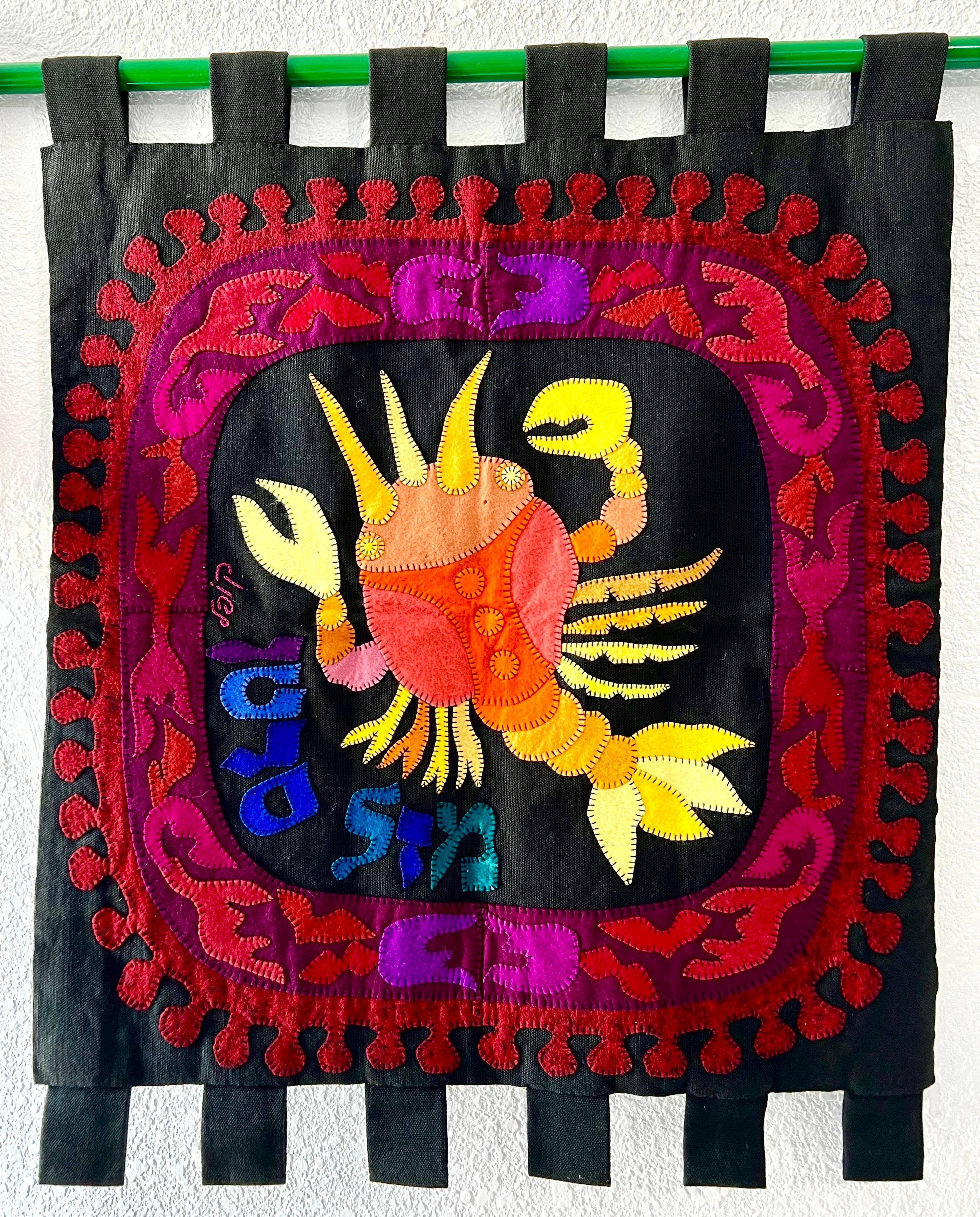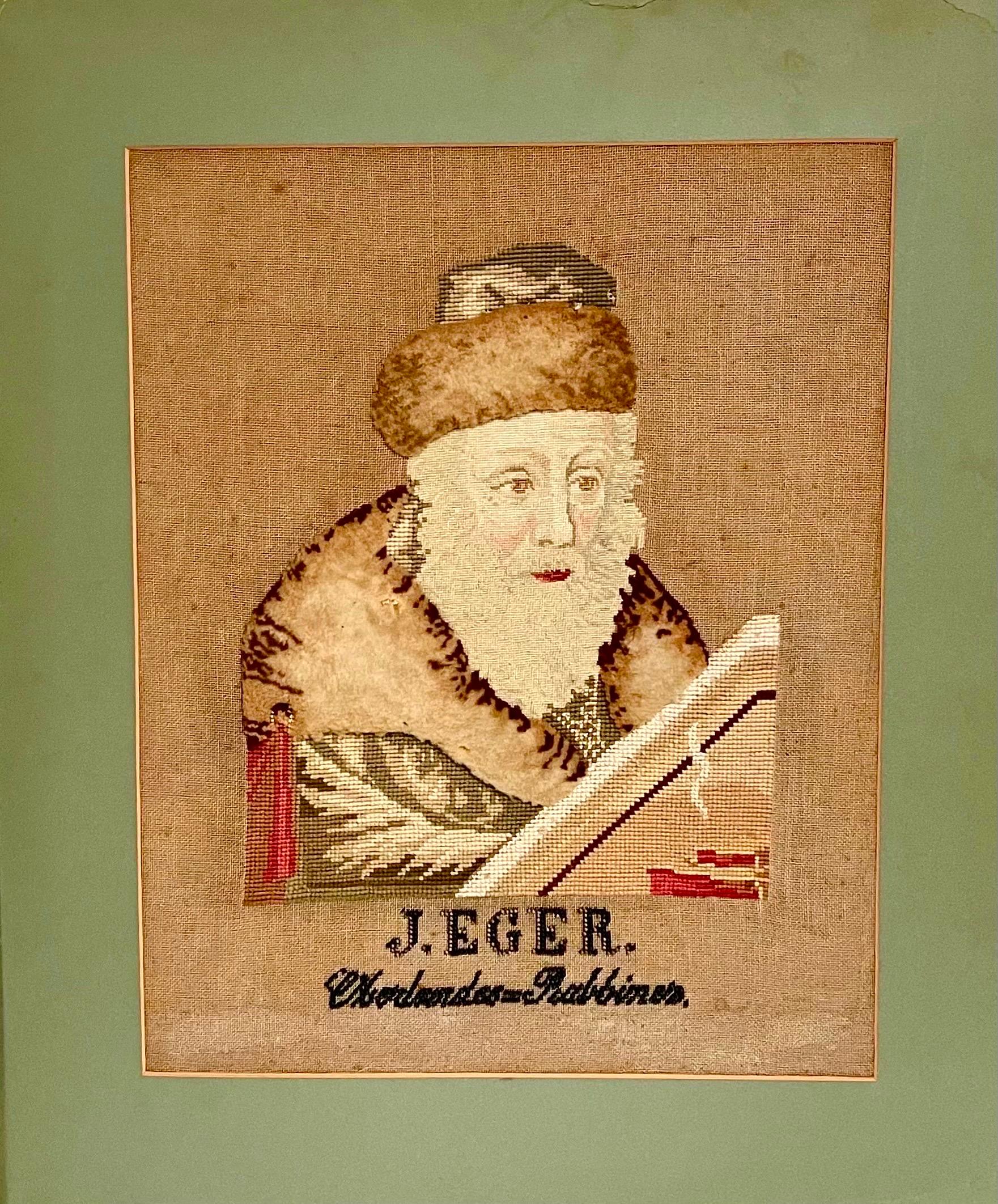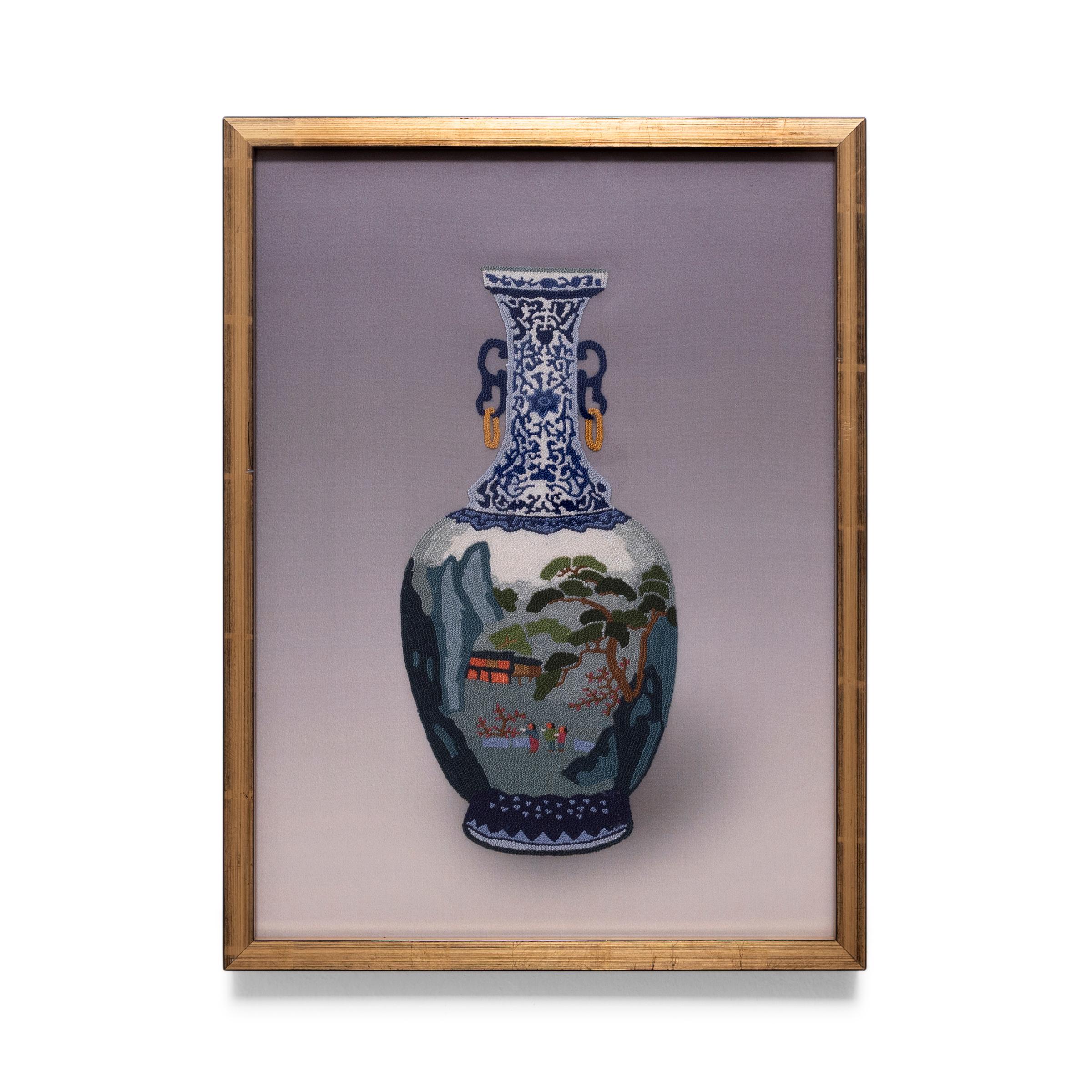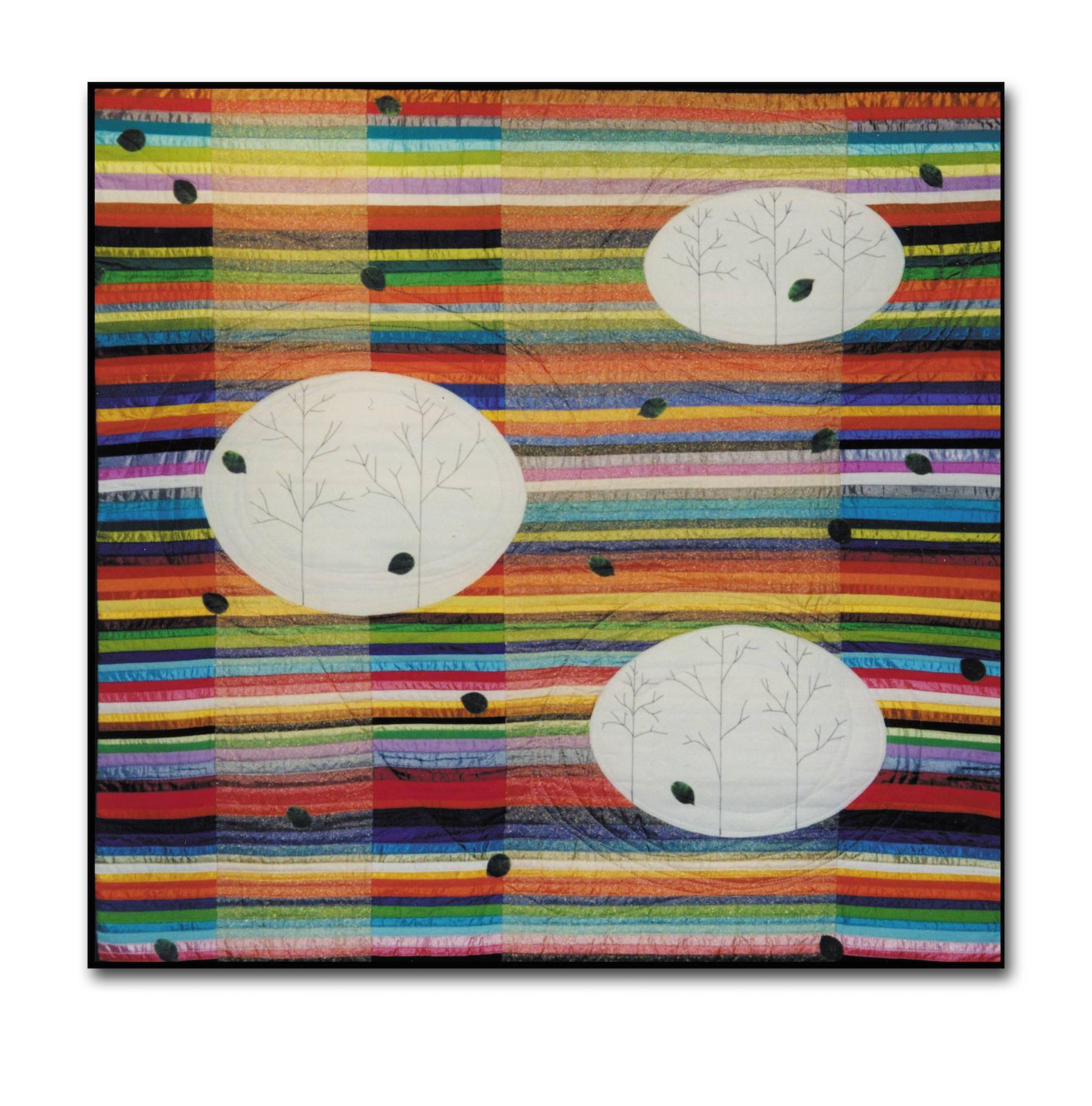Items Similar to SAN BLAS ISLANDS PANAMA MOLA Multi-Layered Fabric Handmade Custom Frame Folk Art
Want more images or videos?
Request additional images or videos from the seller
1 of 9
UnknownSAN BLAS ISLANDS PANAMA MOLA Multi-Layered Fabric Handmade Custom Frame Folk Art1980
1980
About the Item
This is a handmade mola sewn by the San Blas Indian women. Approximate date is 1980. It is framed and protected by conservatorship class. When the gallery framed it we let the strings show on the linen mat. This was purchased on a trip to San Blas in 2002 and has been well protected. Framed size is 15" x 23".
100% of the proceeds will be sent to Darien, Panama to support a youth boxing program. One boxer will be in the Olympics 2024.
Panama is a nation full of colorful imagery, from the aquamarine seas lapping at the country’s coastlines to the deep green canopy of rainforests shrouding its interior. But perhaps the most iconic example of its vibrancy is a traditional garment known as a mola.
Smithsonian :
For centuries, the Guna (previously known as Kuna), an Indigenous group residing in Panama and parts of neighboring Colombia, have been creating colorfully embroidered clothing. A mola, which translates to “shirt” in the Guna language, is a piece of traditional dress typically worn by women and known for its bright colors and intricate designs depicting flowers, birds, reptiles, animals and other emblems indicative of Mother Nature. The textile art began in the San Blas Islands, an archipelago off the northern coast of Panama that’s part of the Guna Yala Region, where many Guna people continue to live.
Making a mola the traditional way isn’t for the faint of heart, and Ledezma estimates that a single shirt can take anywhere from 60 to 80 hours of labor to sew. To create each garment, women and girls use a technique called reverse appliqué, which involves layering two or more fabrics of different colors and sewing them together, then using a pair of scissors to carefully snip away parts of each layer to reveal the design. Next, they use fabric remnants to fill in each layer, creating a striking geometric-like form. The more layers used, the more complex the final piece, which is adorned with intricate embroidery sewn by hand. Often, the base fabric of a piece is black to help emphasize the other colors and make them pop on the finished garment.
several museums in the United States feature molas in their collections, such as Smithsonian’s National Museum of the American Indian in New York City and the William Benton Museum of Art on the University of Connecticut campus in Storrs, Connecticut.
- Creation Year:1980
- Dimensions:Height: 13 in (33.02 cm)Width: 15 in (38.1 cm)Depth: 0.75 in (1.91 cm)
- Medium:
- Movement & Style:
- Period:
- Condition:
- Gallery Location:Houston, TX
- Reference Number:1stDibs: LU1405211195032
About the Seller
5.0
Gold Seller
These expertly vetted sellers are highly rated and consistently exceed customer expectations.
Established in 1970
1stDibs seller since 2020
119 sales on 1stDibs
Typical response time: <1 hour
- ShippingRetrieving quote...Ships From: Houston, TX
- Return PolicyA return for this item may be initiated within 3 days of delivery.
More From This SellerView All
- San Blas Molas, Multi-Layered Fabric, Handmade, Panama, Custom Frame,Located in Houston, TXThis is a handmade mola sewn by the San Blas Indian women. Approximate date is 1980. It is framed and protected by conservatorship class. When the gallery f...Category
1980s Folk Art More Art
MaterialsFabric
- San Miguel, St. Michael, School of Cusco, Peru, Framed early 1900'sLocated in Houston, TXThis is painting is from the School of Cusco depicting St. Michael the Archangel defeating the devil in battle. It is oil on canvas and is in very goo...Category
Early 20th Century Folk Art Portrait Paintings
MaterialsCanvas, Oil
- Bob Ross, The Joy of Painting, PBS, Acrylic on Panel, The Outsiders, Folk ArtLocated in Houston, TXQuote from Bob Ross "Only a few "Happy Accidents on this One" LOOK FOR FREE 1STDIBS SHIPPING WHEN YOU CHECK OUT Robert Norman Ross was an American painter,...Category
2010s Folk Art Portrait Paintings
MaterialsAcrylic, Wood Panel
- Estee, Oil on Panel, Folk Art, Estee Lauder, Portraits, The Outsiders, 20 x 15Located in Houston, TXQuote from Estee Lauder "Be Strong. Be Confident " Be the Star of your own life". "Keep and eye on the competition but this doesn't mean copying them." Below are other paintings available by Tommy...Category
2010s Folk Art Portrait Paintings
MaterialsAcrylic, Wood Panel
- Paraguayan Ink Drawings from the Chaco #4, Paper, Indigenous Artists, RareLocated in Houston, TXTHE GALLERY PURCHASED AND FRAMED THE DRAWINGS DIRECTLY FROM THE INDEGINIOUS ARTISTS IN THE CHACO.. PROCEEDS WILL GO BACK TO THE ARTIST TO SUPPORT HIS FAMILY AND ART CAREER. The drawings are floating on a mat behind conservation glass. More detailed images can be provided. Articles can be found by Googling " Fondation Cartier Paraguay" One of Efacio Avarez's drawing was displayed in Asuncion. See photo below. These are Ink Drawings from Paraguay which are very difficult to obtain. I heard about them from a South American collector who is on the Top 200 Art Collectors in the World List. Most of the research is in Europe. These are done by the indigenous people in the Chaco Region of Paraguay. Efacio Alvarez...Category
2010s Folk Art Landscape Drawings and Watercolors
MaterialsPaper, Ink
- Paraguayan Ink Drawings from the Chaco #6, Paper, Indigenous Artists, RareLocated in Houston, TXTHE GALLERY PURCHASED AND FRAMED THE DRAWINGS DIRECTLY FROM THE INDEGINIOUS ARTISTS IN THE CHACO.. PROCEEDS WILL GO BACK TO THE ARTIST TO SUPPORT HIS FAMILY AND ART CAREER. The drawings are floating on a mat behind conservation glass. More detailed images can be provided. Articles can be found by Googling " Fondation Cartier Paraguay" One of Efacio Avarez's drawing was displayed in Asuncion. See photo below. These are Ink Drawings from Paraguay which are very difficult to obtain. I heard about them from a South American collector who is on the Top 200 Art Collectors in the World List. Most of the research is in Europe. These are done by the indigenous people in the Chaco Region of Paraguay. Efacio Alvarez...Category
2010s Folk Art Landscape Drawings and Watercolors
MaterialsPaper, Ink
You May Also Like
- Wool Felt Applique Israeli Folk Art Signed Tapestry Kopel Gurwin Bezalel SchoolBy Kopel GurwinLocated in Surfside, FLThis depicts a Crab, In Hebrew Mazel Sartan (the Zodiac symbol Cancer, June-July) all made by hand. woven and stitched. Kopel Gurwin (Hebrew: קופל גורבין) (1923–1990) was an Israeli tapestry wall hanging, painter and graphic artist. Kopel (Kopke') Gurwin (Gurwitz) was born and raised in Vilna, the capital of Lithuania. He spoke Yiddish at home, but simultaneously studied Hebrew at their school which was part of the Tarbut educational network. Kopel was active in the Hashomer Hatzair youth movement. In the 1930s, as a teenager, Kopel helped his parents with the home finances by working in a suit workshop, there he first encountered the art of sewing. With the outbreak of the Second World War and the German invasion of Vilna, the Jews were imprisoned in camps and ghettos. Kopel and his brother Moshe were separated from their parents and were put to work in coal mines and peat. Kopel's parents were taken to the Stutthof Nazi concentration camp where they died of typhus within a month of each other. Kopel's 12-year-old sister Chava was turned over to the Germans by a Polish family and murdered. The brothers were arrested by the Germans, but were saved thanks to the connections of Nina Gerstein, Kopel's drama teacher. They hid in an attic until they were discovered, fled and moved to Riga, where they were caught and sent to the Stutthof concentration camp where they were imprisoned until the end of the war. They were put to work maintaining and cleaning trains and took part in one of the death marches. In July 1946, Kopel and Moshe sailed to Helsingborg, Sweden, as part of operation "Folke Bernadotte", in which Sweden took in ill survivors for rehabilitation. Once he recovered, Kopel worked in a publishing house and later was appointed director of the local branch of the Halutz movement. In 1950 Kopel and Moshe made aliyah to Israel. Kopel worked as a survey for the Survey of Israel Company. In 1951, he enlisted to the Communication Corps and served as a military draftsman. There he won first prize for the design of the front cover of the Communication Corps bulletin. With his discharge from the army at 29 he started studying drawing and graphics at the Bezalel Academy of Arts and Design in Jerusalem. Among his teachers were Isidor Ascheim, Shlomo Vitkin, Yossi Stern and Jacob Steinhardt. At the end of his first year of study, Kopel won the Reuben and Sarah Lif Excellence Award in written studies. During his studies he also won additional prizes: In 1956 he won first prize from the Lethem Foundation in California for poster design. Later the same year, Kopel won the Hermann Struck prize for his drawing on the theme of Jerusalem. In 1957 he won an additional first prize from the Lethem Foundation and second place from the printing company Ortzel for a drawing for a Jewish New Year greeting card. In 1958 he won first prize in a competition to design a poster for Tel Aviv's jubilee. Two years later he won three other awards: First and third prize for designing a poster for Israel Independence Day, celebrating 12 years of the State of Israel. Also that year Kopel won first prize for a poster to mark the 25th Zionist Congress. In 1964 he entered the Independence Day poster competition on the theme of aliyah and won first and second prize. Four years later he again entered the competition on the theme of 20 years of Israel's independence and won first prize. The poster was styled like a Holy Ark curtain with two lions and a menorah at its centre. This poster appeared on the cover of the famous book Jewish Art and Civilization, edited by Geoffrey Wigoder as well as the record Voices of 20 Years, 1948-1968, edited by Yossi Godard. In April 1971 he won first prize in the Independence Day poster competition for the fourth time. Kopel's Folk Art tapestry won the Israeli Independence Day Poster Contest in 1968 With the completion of his studies at Bezalel Kopel moved to Tel Aviv and was hired by Shmuel Grundman's graphics and design studio. Grundman took him to Europe with him to design and supervise the construction of Israeli exhibition pavilions. During his time at Grundman's he discovered the fibrous felt from which he produced most of his wall hangings. At the 1964 Levant Fair exhibition he used felt stuck onto wooden panels for the first time. The first felt wall hanging that Kopel produced was intended for the American Cultural Centre in Jerusalem and its theme was the United States Declaration of Independence. The wall hanging, which measured 2.85 X 1.85 meters, was stuck on a wooden panel. Kopel ordered rolls of felt from France and began work on wall hangings based on bible stories. He used a needle, hand sewing small even stitches with black embroidery thread which framed and highlighted every detail in the work, as well as using appliqué. The interior designer, Alufa Koljer-Elem, introduced him to Ruth Dayan who managed the shop Maskit in September 1967 he opened his first solo exhibition at the Maskit 6 gallery, in which 12 wall hangings were displayed. In light of the exhibition at Maskit 6, Meira Gera, the director of artistic activity at the America-Israel Cultural Foundation, organized an additional exhibition of his works at the foundation's exhibition hall in New York City. The exhibition sparked immense press interest, and was also displayed for a few months at the New York Jewish Museum, from where it travelled throughout the United States. Followed by the exhibition at the Delson-Richter gallery in Old Jaffa, which was later also exhibited at the Jerusalem Theatre. Kopel's tapestry "The Time for Singing has Arrived" was printed on a UNICEF greeting card in 1978 and again in 1981. The Israeli Philatelic Service issued three stamps based on three of Kopel's holy ark curtains and one stamp based on an Independence Day poster he designed. Kopel's creations decorate a large number of synagogues, public buildings, hotels and private collections which were purchased in Israel and around the world. They have decorated, among others, the walls of the King David...Category
20th Century Folk Art Mixed Media
MaterialsWool, Felt
- Hungarian Rabbi Akiba Eger 19thC Judaica Folk Art Tapestry Needlepoint SamplerLocated in Surfside, FLDimensions board backing is 2 X 18.5 board opening is 16.5 X 13 inches 19th Century framed tapestry of a Rabbi, embroidered sampler, with beaded script below. (it reads J. Eger Oberlandes Rabbiner or Oberlander Rabbiner) There is some sort of texture and dimension to his fur hat (Shtreimel) and coat collar. This is being sold without the frame.. Rabbi Akiba Eger (5521-5598; 1761-1838) Rabbi Akiba Eger was one of the greatest scholars of his time, who had a great influence on Jewish life. He was born in Eisenstadt, Hungary, in the year 5521 (1761), nearly two hundred years ago. The city of his birth was a seat of learning for centuries, and his family was a family of scholars and Rabbis.Rabbi Akiba Eger, who was Rabbi in the famous community of Pressburg (also Hungary, but since 1913 it belonged to Czechoslovakia and was called Bratislava). He was invited to become Rabbi of the famous city of Posen, and in fact became the chief rabbi of the entire Posen province, though he did not carry that title. His famous son-in-law, Rabbi Moshe Sofer (known as the 'Chasam Sofer'), Rabbi of Pressburg, who had married Rabbi Akiba Eger's daughter. King Frederick III of Prussia honored him with a special medal. Rabbi Akiba Eger was recognized as a great authority on Jewish law, and many well known rabbis and Jewish leaders turned to him for advice and decisions on points of law. "This sort of art, craft work, emerges from a long tradition of Jewish folk art...Category
Early 1900s Folk Art More Art
MaterialsWool, Mixed Media, Thread
- Forbidden Stitch Embroidery of A Chinese VaseLocated in Chicago, ILA wonderful example of Chinese embroidery, this framed silk textile uses the infamous forbidden stitch to depict a fine blue-and-white porcelain vase....Category
21st Century and Contemporary Folk Art More Art
MaterialsSilk
- Tree Of Life, Contemporary QuiltBy Bethan AshLocated in Brecon, PowysThe inspiration for ’Tree Of Life’ came from a quilt I made for the ‘Quilt Art’ group exhibition ‘Moving On‘. The quilt was called ‘Black Hole’ (Mourning quilt) and describes the fee...Category
2010s Folk Art Mixed Media
MaterialsFabric
- Framed Hmong Appliqué Textile FragmentLocated in Chicago, ILDating to the mid-20th century, this colorful Hmong textile is a classic example of the appliqué technique used for the traditional cloth known as paj n...Category
Mid-20th Century Folk Art More Art
MaterialsTextile
- Creatures of the mined lands Barbara d'Antuono 21st Century textile outsider artLocated in Paris, FREmbroidered textile painting Unique work, hand-signed by the artist Penelope or Parque of modern times, Barbara d’Antuono sews by hand like others recite mantras and decides nothing in advance. She lets images arise without any particular coherence with each other, but to which she gives substance in a kind of urgency, in the form of a strip not drawn but sewn. The exhibition, like the eponymous book, covers seven years of this assiduous and patient work through nearly 30 textile works, real freeze frames made of the emotions and memories of the artist, like so many portraits of humanity. . Her meeting in Haiti with Baron Samedi...Category
2010s Outsider Art More Art
MaterialsTextile




